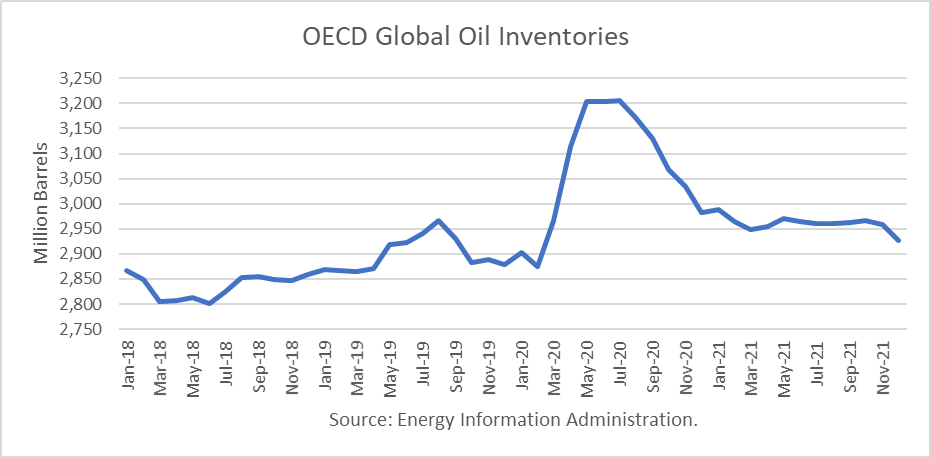The Energy Information Administration released its Short-Term Energy Outlook for November, and it shows that OECD oil inventories likely bottomed in this cycle in June 2018 at 2.802 billion barrels. Stocks peaked at 3.205 billion in July 2020. In October 2020, it estimated stocks dropped by 62 million barrels to end at 3.069 billion, 189 million barrels higher than a year ago.
The EIA estimated global oil production at 91.89 million barrels per day (mmbd) for October, compared to global oil consumption of 95.31 mmbd. That implies an undersupply of 3.42 mmbd or 106 million barrels for the month. About 45 million barrels of the draw for October is attributable to non-OECD stocks.
For 2020, OECD inventories are now projected to build by net 104 million barrels to 2.982 billion. For 2021 it forecasts that stocks will draw by 55 million barrels to end the year at 2.927 billion.

The EIA forecast was made incorporates the OPEC+ decision to cut production and exports. According to OPEC’s press release:
“Adjust downwards their overall crude oil production by 9.7 mb/d, starting on 1 May 2020, for an initial period of two months that concludes on 30 June 2020. For the subsequent period of 6 months, from 1 July 2020 to 31 December 2020, the total adjustment agreed will be 7.7 mb/d. It will be followed by a 5.8 mb/d adjustment for a period of 16 months, from 1 January 2021 to 30 April 2022. The baseline for calculating the adjustments is the oil production of October 2018, except for the Kingdom of Saudi Arabia and The Russian Federation, both with the same baseline level of 11.0 mb/d. The agreement will be valid until 30 April 2022, however, the extension of this agreement will be reviewed during December 2021.”

Oil Price Implications
I updated my linear regression between OECD oil inventories and WTI crude oil prices for the period 2010 through 2019. As expected, there are periods where the price deviates greatly from the regression model. But overall, the model provides a reasonably high r-square result of 79 percent.

I used the model to assess WTI oil prices for the EIA forecast period through 2020 and 2021 and compared the regression equation forecast to actual NYMEX futures prices as of November 19th. The result is that oil futures prices are presently undervalued through the forecast horizon in 2021.

Uncertainties
April 2020 proved that oil prices can move dramatically based on market expectations and that they can drop far below the model’s valuations. In contrast, prices in May through October proved that the market factors in future expectations beyond current inventory levels.
The most important uncertainty is how deeply and how long the coronavirus will disrupt the U.S. economy. Coronavirus lockdowns are seen hitting future consumption as much of Europe is back in lockdown, and restrictions are expected to worsen. The virus is once again spreading across the U.S., and Goldman Sachs cut its first-quarter 2021 U.S. growth forecast to 3.5% from 7% and significantly revised its fourth-quarter estimate for Europe from growth of 9.1% to a contraction of 8.7%.
Bill Gates, whose foundation is heavily involved in the development of vaccines and treatments for COVID-19, told New York Magazine's Intelligencer on September 14, 2020:
“In the very best case, two years from now, you would be, for some of the health things in particular, ideally back at where you were at the beginning of 2020. If we're lucky enough that several of these vaccines work, including the ones that are low cost enough that we can scale the manufacturing," Gates said. And if the vaccines can be mass-produced to "for the entire world," then there is hope," he said. "You hope it doesn't stretch past 2022."
Gates' involvement with developers of treatments and vaccines gives him an "insider's" view and should be heavily considered.
There is some optimism about a vaccine being approved in December for emergency use. But “it has not yet dawned on hardly anybody the amount of complexity and chaos and confusion that will happen in a few short months,” said Dr. Gregory Poland, the director of the Vaccine Research Group at the Mayo Clinic.
It is also unknown how much, if any, of the demand destruction will be permanent due to changes in business, such as online meetings instead of face-to-face meetings, work-at-home, and concerns about flying with infected people.
Conclusions
This pandemic is the biggest market-moving event in the modern history of the oil market. The uncertainties around if and when a safe and effective vaccine will become widely available are significant.
EIA’s November inventory forecast implies oil prices may rise above $50 in the near future and remain there through 2021, based on their supply/demand forecasts. However, their forecast, given the unique uncertainties of a global pandemic, is highly risky.
Check back to see my next post!
Best,
Robert Boslego
INO.com Contributor - Energies
Disclosure: This contributor does not own any stocks mentioned in this article. This article is the opinion of the contributor themselves. The above is a matter of opinion provided for general information purposes only and is not intended as investment advice. This contributor is not receiving compensation (other than from INO.com) for their opinion.

#COVIDISAHOX